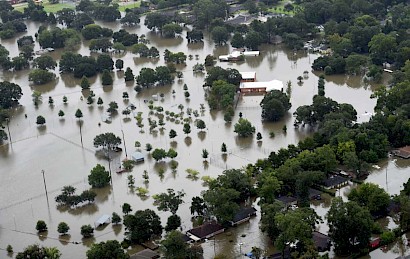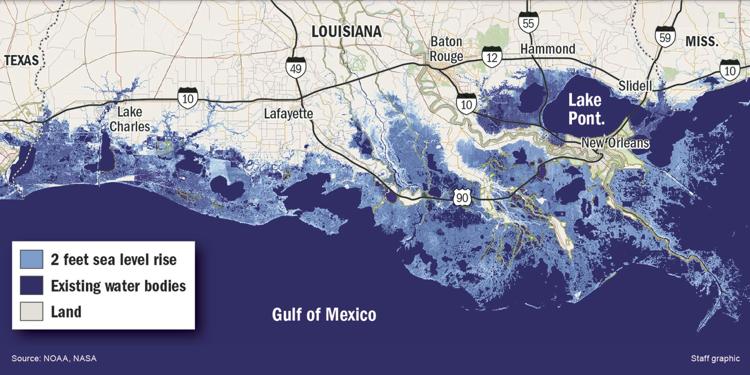Seas could rise 2 feet on Louisiana coast by 2050, 4 feet by 2100, federal officials say
 Water levels along Louisiana’s coast are expected to rise between 1½ and 2 feet by 2050, and could rise over 4 feet by 2100, according to new estimates of the effects of global warming on sea level rise announced Tuesday by federal officials.
Water levels along Louisiana’s coast are expected to rise between 1½ and 2 feet by 2050, and could rise over 4 feet by 2100, according to new estimates of the effects of global warming on sea level rise announced Tuesday by federal officials.
The 2100 estimates for the state are slightly higher than in a 2017 version of the report, which expected Louisiana to see about 3.87 feet of rise by the end of the 21st century.
The report, authored by the National Oceanic and Atmospheric Administration and NASA, also lays bare the havoc global warming will wreak along the nation’s coastlines in the next few decades, predicting an average sea rise of 1 foot by 2050 and 2 feet by 2100.
The higher water levels will result in more tidal flooding for coastal communities and higher hurricane storm surges, scientists said. The spread of higher water inland could also speed the drowning of wetlands and marshes.
“It’s a wake-up call that comes with a silver lining,” said NOAA Administrator Rick Spinrad in a Tuesday news conference. “It provides us with information needed to act now to best position ourselves for the future. It’s going to take all of us – government, businesses, academia, communities, citizens – to make a difference in the future.”
The new federal estimates are based on more detailed modeling of the effects of climate change, including expansion of the ocean’s water molecules because of warmer temperatures and the melting of glaciers and Arctic and Antarctic ice caps, also caused by global warming, according to federal officials.
The federal study warns that even warmer future temperatures than are now predicted could result in much higher water levels, with some worst-case estimates of as much as an 8-foot rise along Louisiana’s coast by 2100.
Those new predictions come as no surprise to Louisiana officials and residents who have been dealing with the state’s rapidly retreating coastline for the last 50 years.
“This report builds upon a body of science that we’ve incorporated into the planning, design, and implementation of every Master Plan project,” said Chip Kline, chairman of the state Coastal Protection and Restoration Authority, which oversees the state’s coastal restoration and hurricane risk reduction Master Plan.
“In fiscal year 2023 alone, CPRA is allocating over $1.3 billion toward the mitigation of climate change and the projected damages we anticipate from sea level rise in the coming decades,” Kline said. “We will continue to work with local communities and our federal partners to invest in the resilience of our coast and proactively address the challenges that lie ahead.

The significantly higher predicted water levels along Louisiana’s coast, nearly double the expected national average, take into account the effects of continued wetland losses and subsidence – the sinking of coastal soils – along the state’s coastline. Until recently, those wetland losses and subsidence made up the majority of sea level rise along the coast.
The coastal authority uses more detailed local estimates of subsidence, as well as federal estimates, both old and new, to decide which coastal restoration and hurricane storm surge reduction projects should be included in the state’s master plan, said Stuart Brown, assistant administrator of the authority’s planning branch.
The Master Plan, which will be updated in 2023, is using a “higher” combination of subsidence and sea level rise that is similar to the federal estimates through 2050, but calls for even higher sea level rise than the federal study’s lower estimate by 2100, he said.
The report is proof that governments and private organizations must increase their efforts to mitigate rising sea levels, local officials and environmental activists said.
“It says that our threats are increasing and that no one in south Louisiana can be passive about the future of our communities,” said Windell Curole, executive director of the South Lafourche Levee District. “We have to actively manage and deal with threats, which includes building infrastructure higher, flood proofing and relocation.”
Relocation isn’t a new phenomenon in Louisiana, Curole pointed out: an 1893 Category 4 hurricane that devastated Grand Isle and the then-community of Cheniere Caminada forced more than 1,500 families to relocate farther north in its aftermath.
Investments in restoration are also needed, said Alisha Renfro, a coastal scientist with the National Wildlife Federation. She warned that part of the threat is to the state’s rich fisheries nursery, located in its coastal freshwater marshes and saltwater wetlands. The state’s Master Plan includes restoration projects aimed at protecting wetlands that are best located to survive water rises, she said.
“We absolutely have to get more sediment into the marshes or we will be left with a skeletal coast, and when that land falls apart, communities are more vulnerable, and the fisheries they depend on,” Renfro said.
The coastal authority’s board of directors was briefed Wednesday by Neil McMillin, director of federal affairs in the Governor’s Office of Coastal Activities, on a long list of new federal money streams headed to the state aimed at reducing risk of future flooding.
The 2021 disaster supplemental funding bill includes hundreds of millions of dollars to complete construction of post-Katrina hurricane levees along the Mississippi River in Plaquemines Parish and to increase the surge protection offered by the West Shore Lake Pontchartrain levee. That levee is finally under construction by the Army Corps of Engineers after 30 years of delays and several major hurricane surge floods.
The 2021 Infrastructure Investment and Jobs Act also included more than $643 million for 21 coastal and water management projects, and $125 million for home and business elevations.
That’s in addition to the more than $800 million being spent by Louisiana on restoration and levee projects in the remainder of fiscal year 2022, and an expected $1 billion or more a year in state funds that will be spent over the next three fiscal years.
Like state-funded projects in the Master Plan, the plans for each of the federal projects is expected to be adjusted to take into account the new sea level rise estimates.
The state also is lobbying Congress and the White House to include money in upcoming spending bills for a new study of the Jean Lafitte region of the Barataria Basin to determine if there are additional ways of assuring residents of those communities can continue to live there, following its inundation by more than 11 feet of storm surge during Hurricane Ida.
Jean Lafitte Mayor Tim Kerner Jr. said his constituents want to see improved protection against possible future sea level rise, though he is a bit skeptical of the new estimates. He said communities outside the levee system make up the state’s “working coast” of fishers, oil and gas industry workers, and residents who are expected to work on future offshore wind farms.
“If you lose places like Lafitte, you can’t park your boat in the Mississippi River or Metairie or Baton Rouge,” and provide the seafood that keeps New Orleans restaurants open, he said.
Kerner said he believes the cost of relocating his residents, whose homes are the second most expensive in Jefferson Parish, will be more than the expected cost of both elevating some of the existing homes and adding to the area’s present levees and floodwalls that are built to protect from tidal flooding.
Using older estimates, federal and state officials have for years made dire predictions about climate change’s effect on sea level rise. In one notable example, officials warned that Louisiana Highway 1 between Port Fourchon and Grand Isle could be hit by high-tide flooding on a near-daily basis by 2050.
“Sea level rise is already an issue for people along the lower coast,” said Alex Kolker, an associate professor of coastal geology at the Louisiana Universities Marine Consortium in Cocodrie. “At LUMCON, we already have water in our parking lot 50 or 70 times a year. This report puts in perspective what we can expect over the next 30 years, which is a critical timeframe when many of us will still be living along the coast.”
You can return to the main Market News page, or press the Back button on your browser.

